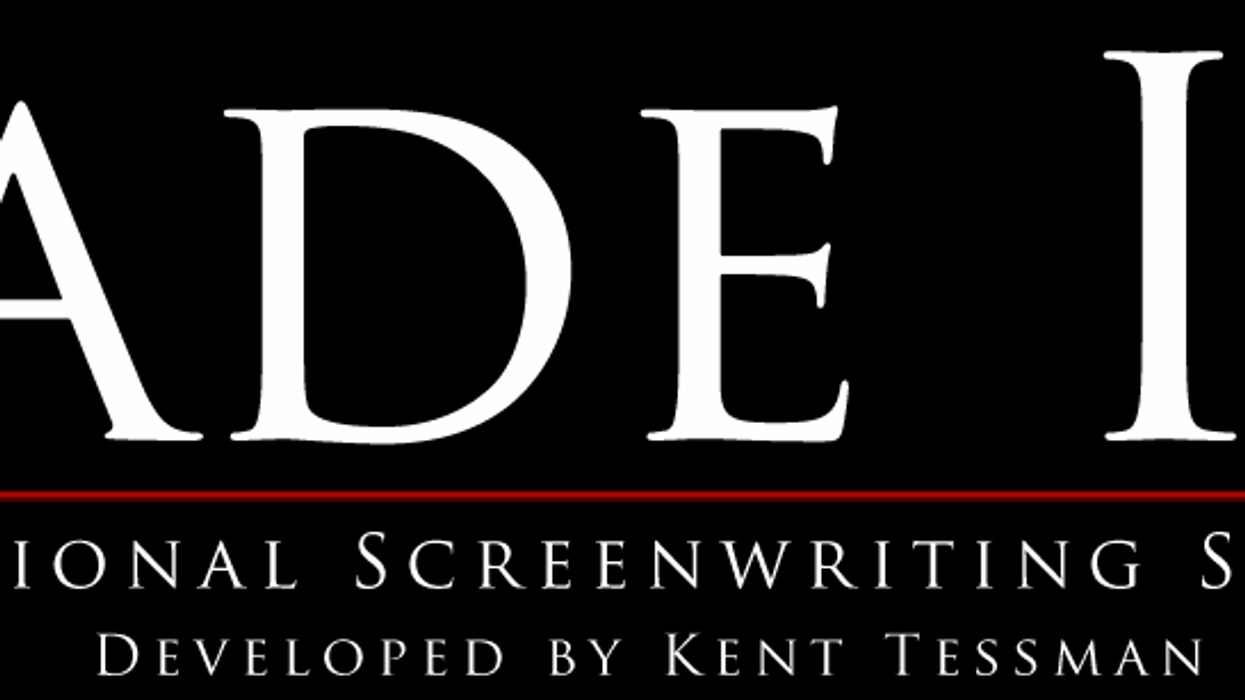'Fade In' Offers a Clean and Inexpensive Alternative to Popular Screenwriting Programs

When it comes to screenwriting software, there's Final Draft -- and then there's everything else. Or, at least, this was the situation for years. I can remember being a teenager (many years ago), getting a copy of Final Draft for Christmas, and being really excited that I wouldn't have to hand-set all the margins and pagination in Word anymore, which everyone knows is excruciatingly annoying. These days, there are plenty of new options, including Fade In, an application that gives Final Draft a run for its money (literally). Click below to check out a review and get a breakdown of the features!
To begin with, there's the issue of price. While the newest version of Final Draft is $249, or $79 for an upgrade from a previous version, Fade In is currently just $49, and its usual price is $99, which is a big plus for the screenwriter on a budget (and pretty much every screenwriter I know is on a budget).
Fade In was developed by Kent Tessman, a filmmaker who was dissatisfied with Final Draft, though he had been using it for years:
Final Draft has always been a bit like writing in a funhouse mirror by strobe light. Glitchy text rendering, big chunks of the page not getting redrawn properly, traces of (non-)blinking caret left behind all over the place like breadcrumbs. Final Draft 7 in particular was a bit of a fiasco. Getting back to some writing projects after finishing up a feature, part of me hoped that Final Draft 8 would heal the litany of ailments suffered by its predecessors. But firing up the latest and brand-newest Final Draft on a brand new computer proved that would not be the case.
To solve his quandary, Kent wrote a new application, which runs on Mac, Windows, Linux, and has versions for iOS (iPhone and iPad) and Android. I tested it on a 2012 Macbook Pro running 10.7.5. The interface of Fade In is very clean, but deceptively simple. It's an easy to use, intuitive screenwriting application, and runs at a brisk pace, with very little delay:
Features
Here's a side-by-side comparison of features between Fade In, Final Draft 8, Celtx, and Adobe Story. Some of Fade In's features are: WYSIWYG editing, Full Unicode Support, the ability to Modify script styles, custom formatting, text highlighting, line length adjustment, more and continued, revision page colors, scene number locking and many more. Besides the traditional screenplay format, there is the option to write a stageplay, half-hour sitcom, or one-hour drama. Additional formats, such as Cole and Haag, Warner Bros., and others such as A/V, radio and even a graphic novel template can be downloaded from the site.
Compared to Final Draft and Celtx
That being said, Fade In doesn't have the numerous pre-production elements native to applications like Final Draft and Celtx. In Fade In, it is possible to create index cards (they are generated automatically based on the number of sluglines, but you can't add more, for instance to create a board with your scenes before writing them.) They're also monochromatic and not as detailed as the color-coded options in Final Draft, where specific production elements can be marked and organized. And Celtx, a free application (with the option of a $14.95 add-on), features a number of ways to nest projects and notes within projects, allowing for a sort of online file cabinet; it also has a plethora of elements like storyboards that can be cross-referenced , though for it to work as a production workflow tool, the entire production has to be using Celtx (which won't export to Final Draft or Movie Magic, the two industry standards.) There are workarounds for exporting Celtx, but they involve exporting the file as either text or HTML, then importing to your application of choice and going through all the headaches of reformatting that usually entails, especially with Final Draft.
With regard to import/export options, Fade In can import Final Draft and Celtx files (though it can't export Celtx files). Final Draft can import text files, RTF files, and FCF (file converter files), and it can export to text, rich text, other Final Draft versions, and send production information to Avid and Movie Magic. Celtx can only import or export text or HTML files.
Fade In uses the traditional keyboard shortcuts (e.g., on a Mac, ⌘1 for a slugline, ⌘2 for action, etc.) so it's not confusing to get started. Fans of Fade In include The Hangover 2 and 3 screenwriter Craig Mazin and Children's Hospital writer and comedian Rob Corddry, who jokingly referred to it as, "Final Draft without the suck."
Final Thoughts
Writing with Fade In is a pleasure. Its clean, two-color, three-panel interface and speed make it a lean greyhound of an application, perfect for writing. If you want to get much more complicated, or have other production needs, then Final Draft, Celtx, or Movie Magic are probably for you. But Fade In is a great writer's program. I frequently use Write Room for writing fiction, and I would say that Fade In is its screenwriting counterpart in terms of ease-of-use, design, and functionality. It does one thing, but it does it very well.
For those on a budget or who find themselves dissatisfied with Final Draft, or simply want a clean, writing-based screenwriting application, Fade In is a great, economical alternative that can do almost everything the big boys can, and can export to Final Draft (something Celtx can't do). Movie Magic is still the standard for production planning, but as far as a writing program goes, Fade In is a solid application for a reasonable price.
What's your experience been with screenwriting software? Have you tried Fade In? Would you be willing to? Or are you a holdover who still writes on a typewriter, or (gasp) by longhand?














